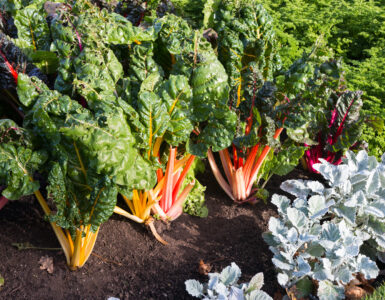Michelle Virtue with BYU Campus Craft & Floral reveals the best bouquets for every kind of vase.
_____________________________________________________
BEST BOUQUET FOR AN URN-SHAPED VASE
Ideal Flower Match: Tulips (shown) or other species with long, supple stems, like ranunculus. Large blooms (lilies, peonies) that need room to open are good choices, too.
Why the Pairing Works: After being cut, tulip stems lengthen up to an inch and the blossoms get larger; tulips also stretch toward the light. A wide mouthed urn gives them space to “move and do their thing,” says Ian Prosser, who owns the Botanica International Design Studio, in Tampa, and has created floral displays for three U.S. presidential inaugurations.
How to Arrange a Bouquet: If you like tulips that droop a little, leave them on the table for 10 minutes before putting them in water, says Prosser. This softens the stems, causing the heads to hang down. Set the flowers around the perimeter, then fill in, angling the stems to create an arch.
BEST BOUQUET FOR A BUBBLE VASE
Ideal Flower Match: Sweet peas (shown), poppies, or gloriosa lilies.
Why the Pairing Works: A bubble-shaped vessel with a small, ruffled opening helps rein in unruly blooms while keeping the arrangement loose. That’s key for vine flowers, such as sweet peas, which can get “mildew” if tightly clustered, says Meredith Waga Perez, a co-owner of Belle Fleur, a floral- and event-design company in New York City. Because they stand about 10 inches high, sweet peas require a low vase.
How to Arrange a Bouquet: Trim the stems, take a bunch in hand, then casually let the blooms drop into the container all at once so they spill around it, says Cecelia Heffernan, owner of the floral shop Flower Hardware, in Wilson, Wyoming, and the author of Flowers A to Z (Harry N. Abrams, $23, www.amazon.com).
BEST BOUQUET FOR A CYLINDRICAL VASE
Ideal Flower Match: Hydrangeas (shown) and other flowering branches, peonies, sunflowers, or any bloom with a large head and a bulky stem.
Why the Pairing Works: The height and the narrow shape of a cylinder can “make an abundant bouquet of shrub like flowers look more controlled,” says florist Ian Prosser. Hefty hydrangeas work best in a thick glass or ceramic container.
How to Arrange a Bouquet: For a lush, organic feel, cut the stems to different lengths, leaving them all four to six inches taller than the vase. Hydrangeas wilt quickly, so to help the woody stems draw in water, cut them at an angle, then hit the bottoms lightly with a hammer to splay the ends. Loosely place the flowers, putting some on one side, rotating the container, then adding more to the other side.
BEST BOUQUET FOR A SQUARE VASE
Ideal Flower Match: Hyacinths (shown), daffodils, or amaryllis, which all have weighty heads and delicate, stick-straight stems.
Why the Pairing Works: A crisp square vase calls for equally graphic blooms. The elongated cone-shaped heads of hyacinths soften the angular, compact vessel, which handily props up the top-heavy flowers. Choose contrasting colors, like velvety purple and stark white, for a modern look.
How to Arrange a Bouquet: Cut off the white root at the base of each hyacinth; the leaves will fall off. Rinse the stems and the leaves. Angle the blooms around the perimeter of the vase so that they stick out and some heads rest on the rim. Position a few stems at slightly different heights in the middle. Tuck in the leaves at regular intervals throughout.
Tip: Display daffodils on their own, rather than
in mixed arrangements. Their stems secrete a poisonous sap that can harm other flowers.
BEST BOUQUET FOR A BUD VASE
Ideal Flower Match: Freesias (shown), lilies of the valley, clematis, poppies, or scabiosas. Any variety with thin stems will do.
Why the Pairing Works: A curvy bud vase with a slender neck secures a freesia nicely and accentuates its lithe silhouette. A freesia is delicate, so it won’t tip over a miniature vessel. Florist Meredith Waga Perez suggests spreading the wealth, placing freesia stems in a few vases of various heights along a mantel or on a dining-room table. “It makes a more unique impression than one large centerpiece,” she says.
How to Arrange a Bouquet: Trim the stems. For a balanced look, gather a grouping of flowers that naturally point in opposite directions. Set in the vase. As the freesia blossoms start to die, pinch them off to encourage new growth, says florist Cecelia Heffernan.
BEST BOUQUET FOR A ROUNDED VASE
Ideal Flower Match: Roses (shown) or other species with rigid stems, such as daisies, chrysanthemums, and carnations.
Why the Pairing Works: Flowers with sturdy stems can stand tall in a container that has a generous opening, which also allows you to pack in a lot of blooms and spread them out in a sculptural dome. A spherical vase beautifully echoes the circular heads of roses.
How to Arrange a Bouquet: Remove any leaves and thorns with floral shears, or snap them off with your fingers, says florist Meredith Waga Perez. (If you wish, retain a few leaves for a green accent.) Group a bunch of roses on one side of the vase and mirror it on the other. Designate the center for flowers that are an inch or so taller than the others.
______________________________________________________
For a great selection of fresh flowers and home décor, visit BYU Campus Craft & Floral:
Campus Craft & Floral
1021 WSC
Provo, UT 84602
(801) 422-2840
www.campuscraftfloral.com















Add comment